Not Just Boring Machines
New Britain (Google Maps Location)
October 6, 2006
There’s a lot going on here. First and foremost, my good friend and partner in crime who appears in some pictures below and even contributed a few paragraphs, passed away in May 2016. Ed was largely responsible for the creation of CTMQ. Please read my tribute to him here. Ed was one of the great ones.
Also, this page is sort of THE page on this giant website. My very first museum! The sign in the picture below is how I begin all my talks; it, coupled with Ed’s encouragement, birthed the whole idea for this site.
The folks who run the NBIM have always been kind and are aware of their place in “history,” such as it is. They’ve expanded since our 2006 visit and they are still one of the most unique and interesting museums in the state. I’ll always have a soft spot in my heart from the NBIM.
The museum moved to a storefront on Main Street in downtown New Britain in 2019.
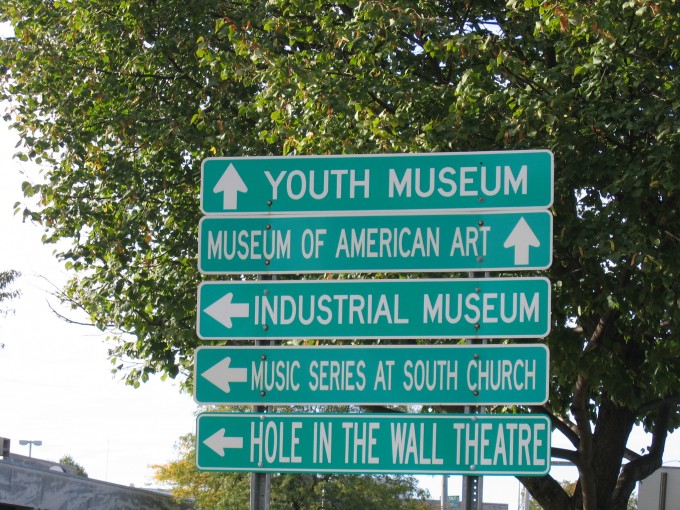
The sign that started it all
The New Britain Industrial Museum was, to me, the perfect place for me to begin my quest to visit every museum in Connecticut. There are many reasons for this, but the one I most mention is the sign above. For the last several months of picking up my son at my in-law’s house, I would sit and wait at a traffic light staring at that sign. My wife, Hoang, assured me several times that all New Britain elementary school students visit both the Youth Museum and of course the town’s regionally renowned art museum. But… what was this “Industrial Museum?” No one had ever heard of it – not even native New Britskies.
Day after day I stared at that sign becoming more and more bemused by the idea of a quirky museum in a proudly gruff post-industrial town. “How big is it?” I wondered. And, “who maintains it?” More importantly, “who visits it?” A few months went by and then this whole “Museum Quest” idea hit me.
There must be a bunch of these “weird” unknown little museums around the state. I figured that no one had visited them all before – let alone write about them all. Day after day, I formulated the idea for this site, staring at that sign. There were three museums printed on it right there! How many more could there be?
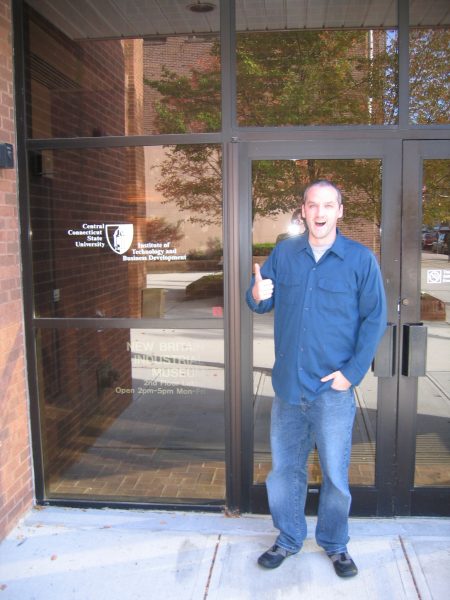
Yes, I wore an old Dickies shirt to appear more “industrial.”
I bounced the idea off of Hoang and a few friends. Sure, they’d join me here and there, but this was to be my baby. I set to work on the massive list of museums. I never expected to find so many museums in our small state – the third smallest state in the whole country by the way. Wow… Imagine how annoying I will be at future cocktail parties? Or rather, imagine how much more annoying I will be once I know everything there is to know about our state? “Hello, I’m Steve and this is my lovely wife, Hoang. Nice to meet you. I’m from Delaware originally but Hoang grew up in New Britain. Yes, New Britain – you know… The city whose companies were granted more patents between 1812 and 1820 than any other city in the US. And that includes Menlo Park, NJ at its height if you can believe that!”
I hate me already.
I talked with my friend EdHill and we agreed that the NBIM would be my first true museum visit as it fit some very important criteria: It was open, it was centrally located between our workplaces, it was presumably odd, and, well, as I said above: it was the one which piqued my interest in visiting Connecticut’s museums in the first place.
Little did I know that the NBIM would become somewhat legendary in the future lore of CTMQ. The very first! And that unassuming highway sign; to be talked about and featured in every talk I would ever give in the future!
Of course, this story is made all the better because of the fact that the NBIM is pretty great.
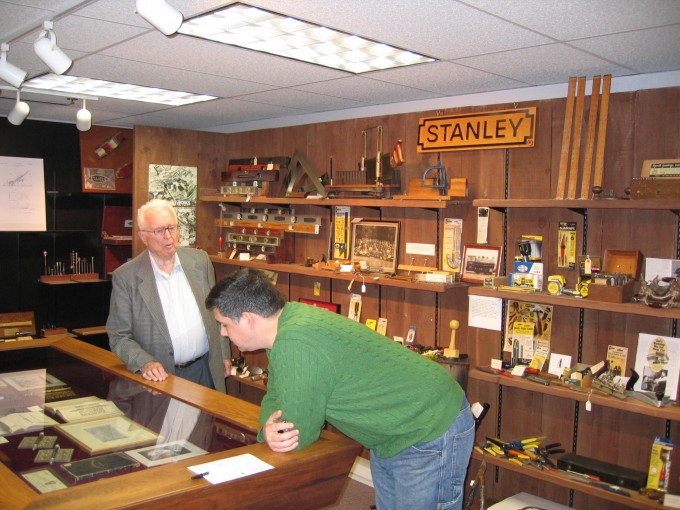
Warren Kingsbury and EdHill
EdHill and I met up in front of the building on downtown New Britain’s Main Street at 4:30, giving ourselves a mere 30 minutes to peruse what we thought would be dusty collection of precision machine parts and old tools. Looking back, I suppose that would be enough time for an average nerd like myself to walk around the large one-room (partitioned) space by myself. But upon arrival, we were warmly greeted by a gentleman who appeared to have been sitting there waiting for us. He begged us to sign the visitor’s log and immediately handed out gifts – small, red, highly reflective stickers from some local company called Reflexite. I dropped a few bucks in their donation jar and the next thing I knew, we were getting a personal tour from the man.
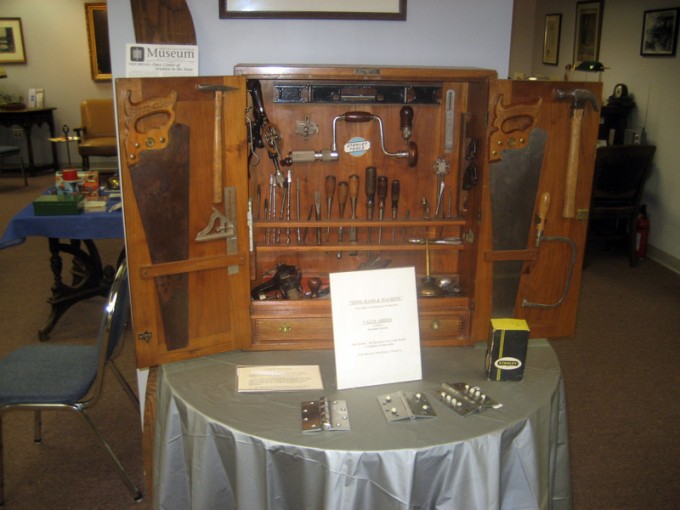
I immediately knew that this is what this website would be all about. This was exactly how I’d hoped these small little-visited museum visits would play out. To Warren Kingsbury (the gentleman), the NBIM was a labor of love. For him, the rich history of New Britain’s industrial past was something to be proud of and something to share. I immediately knew that he often yearned for the bustling city of 1918 rather than the drug-ridden shell of a city it has become in the early 2000’s. It was impossible not to get excited about this stuff – even though the large majority of the collection is, well, rather mundane.
(I should note that I still love New Britain. My in-laws live there, my wife was raised and educated there. The art museum is one of the best around – and who can’t love Broad Street and the whole “New Britski” thing?)
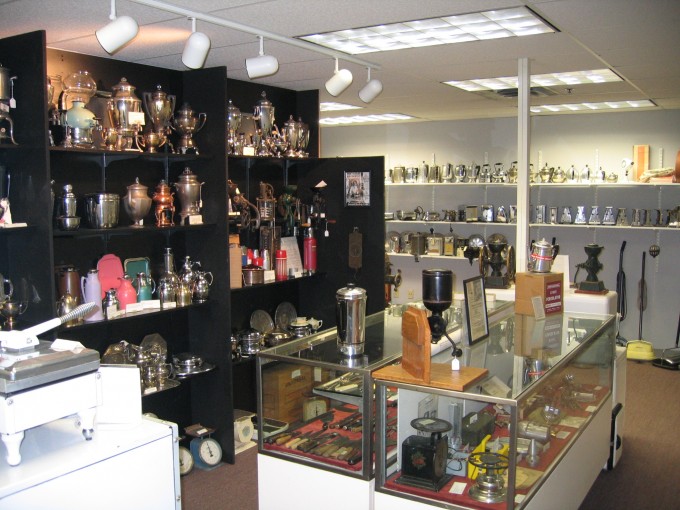
Lots and lots of coffee pots… and blenders. And irons. And vacuum cleaners. And…
Warren excitedly led us to the museum’s newest acquisition – a really old pistol made by Simeon North (1765-1852). Ok, I don’t care much about old pistols and I’d never heard of Simeon North, but it was hard not to get excited when Warren was practically fondling the thing.
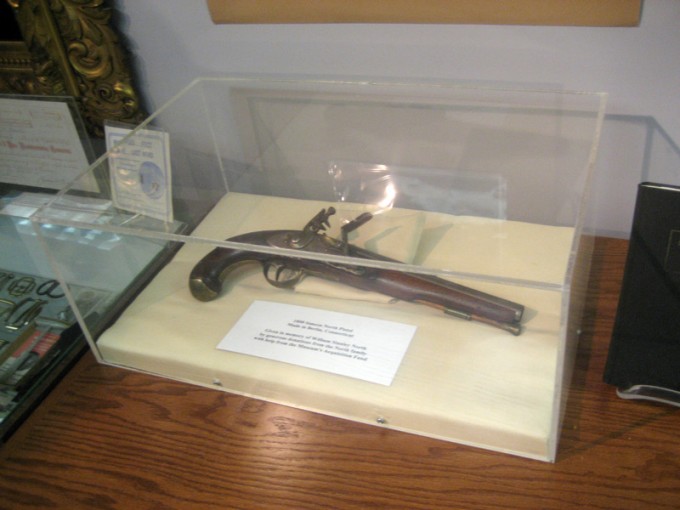
Simeon North gun
Ed listened while I wandered a bit. The museum consists of several display cases and lots of wall space chock-full of old… um… industrial “stuff.” The evolution of the belt sander. The evolution of the vacuum cleaner. The evolution of the meat grinder. The evolution of the coffee pot – one particular model had the following warning imprinted on the base:
“Do not put in water.” After receiving hundreds of telegrams and Pony Express deliveries (or whatever), the company changed the wording to, “Do not immerse in water.” That, my friends, is good stuff. Despite the fact that Warren has probably told that story 500 times, it still gave him a good belly laugh.
I was enamored with our tour guide.
After getting a good idea of what was ahead of us, and after finding a little out-of-the-way display of a model of a machine with Star Trek The Next Generation’s Chief Engineer Miles O’Brien manning the controls –
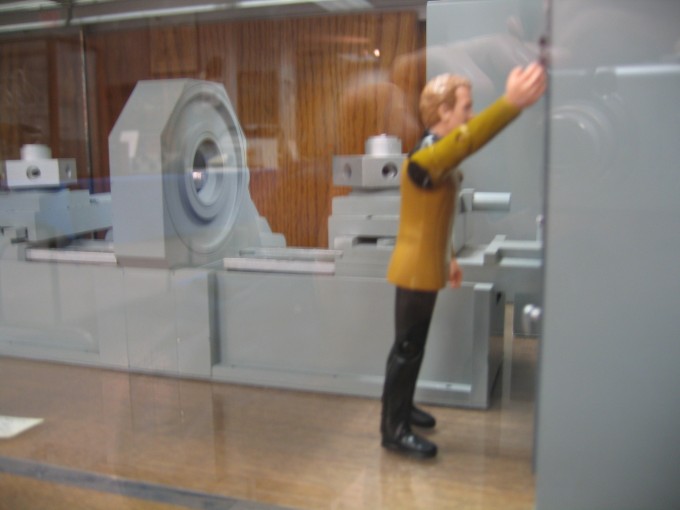
Miles O’brien
Warren pulled me back in with a detailed description of the North and Judd company’s fascinating “Horse and Mule jewelry” collection and their “Hook flex fastener” invention (the thing on all of our pants if they’re not button or snap). I was also schooled about Simeon North. He is “The father of New Britain industry.” And I’ll never forget it.
Before moving on to the Landers, Frary, and Clack section (coffee pots and heating elements), Warren blurted out that one of the metal farm animal implements on view was called a calf weaner. Aha! The first double-entendre of CTMQ! I wanted to know more about the weaner, but the sign was slightly obscured; the mystery of which only left me thirsty for more weaners.
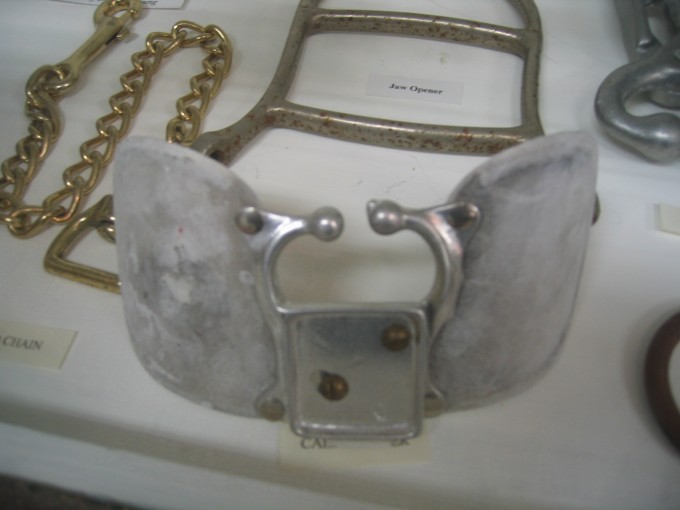
A nice weaner
We wandered the back section a bit and I noted that Warren conspicuously completely skipped the silliest display of all. But I won’t – the Tuttle and Bailey company enjoys a lovely display of air vents and heat registers. I was mesmerized by the complete… um… blandness of the display. But I guess the company has a winning formula as they’re still in business selling the same products as of 2006. I suppose they found their niche.
From there we learned about Raymond Engineering’s history and their early “black boxes” and missile guidance systems. Good stuff. Up next was the Corbin Company display. Corbin was a major player in early New Britain and made everything from locking mechanisms to door mechanisms to mail slots to cars. If it was metal, they made it. In fact, next time you are in an oldish administrative building or church, note the copper colored thing that eases the door closed. Chances are it’s a Corbin!
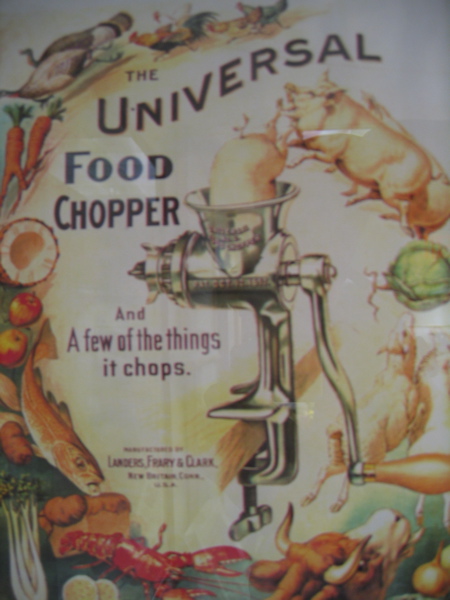
Over the next 10 years of museuming, I’d see this poster in a dozen different places.
A subsidiary of Corbin (Berlin Steel) made all the bolts and metal joiners for both of Connecticut’s first casinos. But it was Warren’s admission after I sarcastically quipped to Ed upon seeing the small antique lock and key display that struck me more. I said, “Boy Ed, just wait ‘til we get to the Lock Museum in Terryville!” Warren looked me in the eye, inhaled deeply, and intoned, “I am jealous as hell of the Lock Museum!”
Aren’t we all, Warren, aren’t we all. Turns out, those elitist snobs over there at the Lock Museum got 3 million bucks from the lock industry so they outbid the NBIM every time any of a New Britain company’s historical locks are on eBay or at some obscure auction somewhere. Not only that, they got to build their own building to house their collection while the NBIM still must rent a section of floor room from CCSU’s downtown building. I promised to treat those uppity lock jerks accordingly when we get out there. Anyone that upsets Warren upsets me.
*Update: I visited the Lock Museum three-and-a-half years later. But didn’t give anyone grief.
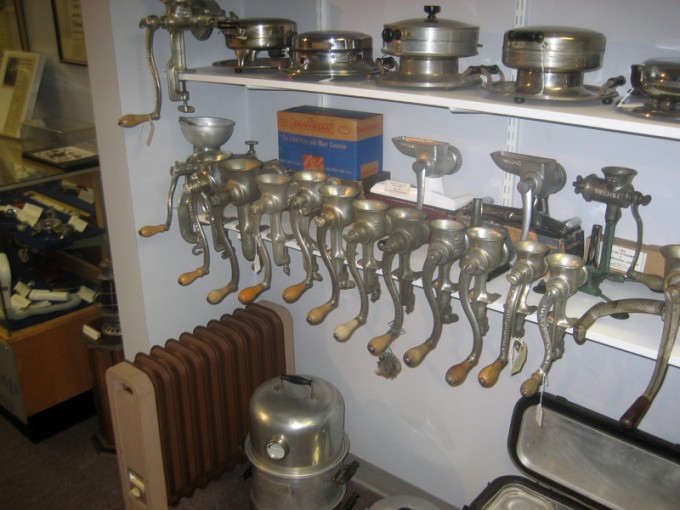
The Corbin car company operated for 10 years back when Henry Ford was perfecting the Model T and the assembly line. They only produced 600 cars and only a few exist today. But get this – the first driver’s license issued to a female was in New Britain to some girl who fell off a horse and needed to get around. And she got around in a Corbin. Like I said, we’re gonna be big hits on the party circuit next year!
After a quick jaunt through the history of food grinders (“This one was to smush up tomatoes exclusively!”), some sabers that General Patton had a patent on, and the first paper cup AND first wax-coated paper cup, we moved on to the Stanley exhibit. Stanley Tools IS New Britain. Or, rather, Stanley Tools WAS New Britain. EdHill’s Grandpa worked there. My father-in-law did a stint. Unfortunately, they now do most of their manufacturing in China – save the tape measures that are still produced in New Britain. They are still headquartered here as well – but only after an attempt to move off-shore for tax-saving purposes.
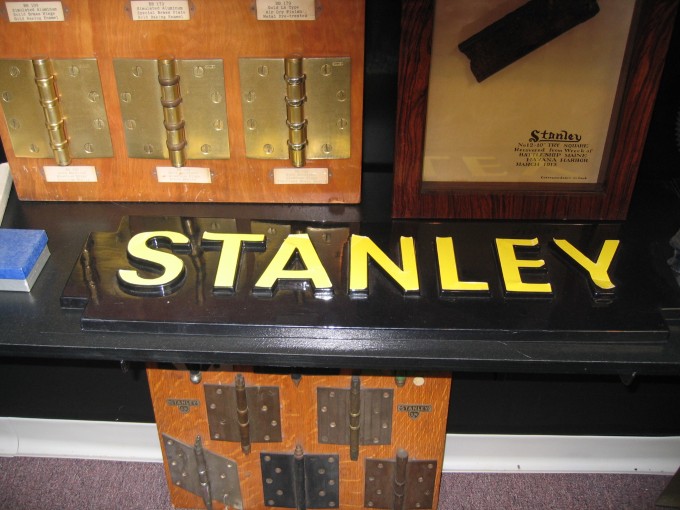
The Stanley collection is the star of the show. Each antique tool is worth hundreds of dollars – in fact, one teeny tiny little folding ruler about the size of my pinky was said to be worth $600. At this point I realized it was past 5 o’clock and Warren was keeping the joint open just for us. We apologized and he acted as though we were crazy for doing so. We still had to get to the tape measure, saw, and router displays! (EdHill got excited for a second at the mention of routers until he realized there were no computers involved.) After that, it was over to the back wall and a real boring machine.
“Boooooooooooring,” I said. Warren smiled and said, “You bet it is son, check this out!” He showed off how the gear ratio made it even more boring. Warren, for his part, was immune to the pun. Either that or I’m only the 873rd visitor to make that lame joke and his 6-minute discussion of the boring qualities of the boring machine was his secret way of getting jokers like me back.
Which would be brilliant.
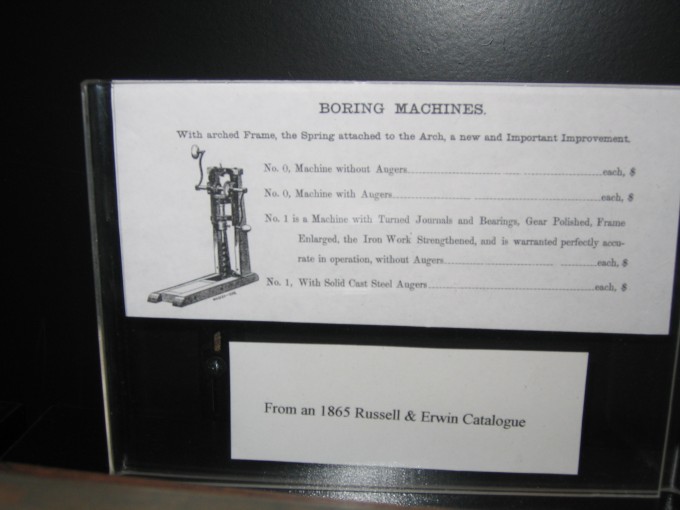
At this point it was almost 5:30 so we decided to skip a few displays. I’ll be sure to hit that corner first next time I go – and you can be assured there will be a next time. My pops would get much more out of the museum than I did – his father owned probably half of this stuff and what’s more, my dad knows how to use all those tools.
I only know how to watch my dad use all those tools.
Just before leaving, an elderly guy (a Mr. Van Dorn) ambled out of the office to thank us for coming. He was curious where we were from, seeing as though we took more pictures of the place than probably anyone in its history. I spoke the truth and he was genuinely excited for us and eager to see what you are reading now. I promised that I’d send the link and hook him up with the book when it comes out.
Mr. Horace Van Dorn conceived this museum in the early-1990’s. He retired as the Vice President of Engineering at Fafnir Bearing and passed away in 2010. He did more impressive things in his life than ten of us combined.
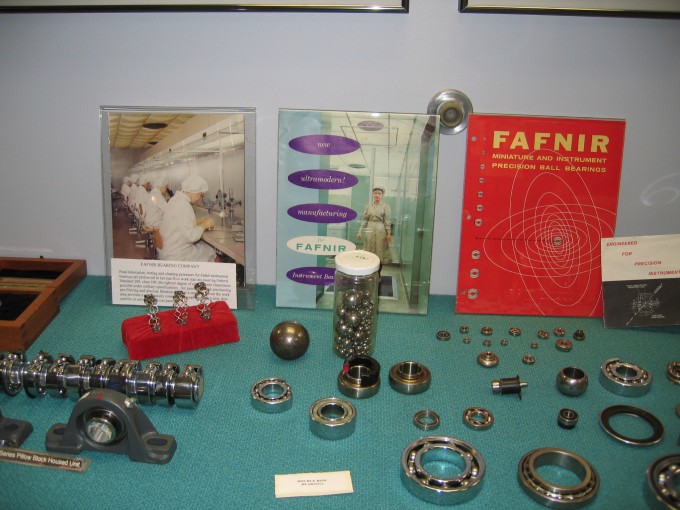
While we’re at it, Warren Kingbury also passed away in 2010. Everyone on this page besides myself is no longer with us.
The two volunteers were both lovely men and left us with such a good feeling about knowledge and history and learning (and cool free Stanley keychain screwdriver tchotchkes to boot). It was great to meet them and get a personal tour of the museum.
If 10% of my visits go this well, I’d consider CTMQ a resounding success. Especially if, as a last gesture of goodwill before leaving, each museum sets up such an easy joke as this:
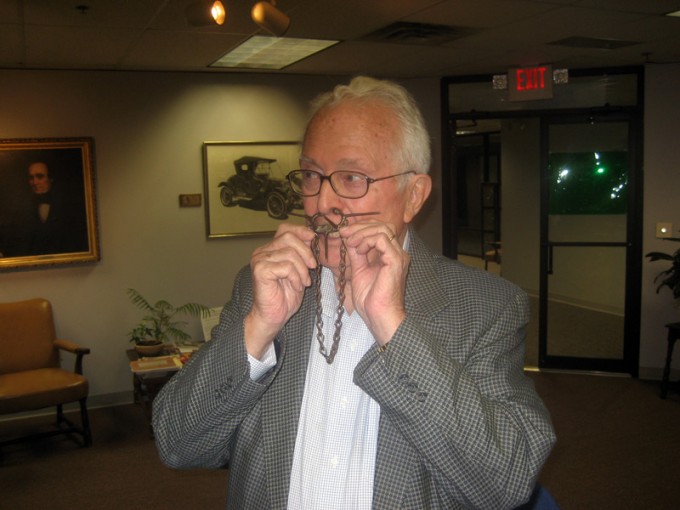
Warren takes a weaner to the face
EdHill says:
Where can you go to one museum that has displays on missile guidance systems, surgical drill bits and a bunch of toasters? Why The New Britain Industrial Museum of course! Stop being so stupid. Seriously, you’re an idiot for not knowing that.
I found myself having a bit more of nostalgia for this museum than Steve did, for my mother grew up in New Britain and my grandfather worked at Stanley Works. Growing up I was so used to seeing all sorts of Stanley tools, Stanley tape measures, Stanley everything, at my grandparent’s house and at their beach house (Back then you could work at Stanley works in New Britain and afford a summer home. Go figure). And here was all the same stuff behind glass in exhibits. Funny hearing Warren Kingsbury go on and on about the rarity of the tool box collection preserved in a glass case and me thinking “gee, didn’t I used to play with this thing at Grampa’s house?” Family legend in my house, Grandpa was on his way to work and getting off the bus; landed wrong and broke his ankle. Since the hospital was a longer walk than Stanley, he just went to work. My gramps was a badass.
The museum had a large birds eye view of the huge Stanley works building in its prime. It was quite impressive and interesting since I never knew what the place looked like and now I have a picture in my head to match the family history. But like everything else in Hartford, if it was historical and interesting, it probably got destroyed to make room for a highway. All that was left was the plaque from the main entrance sitting right below the picture, in a second floor museum in downtown New Britain. Sad.
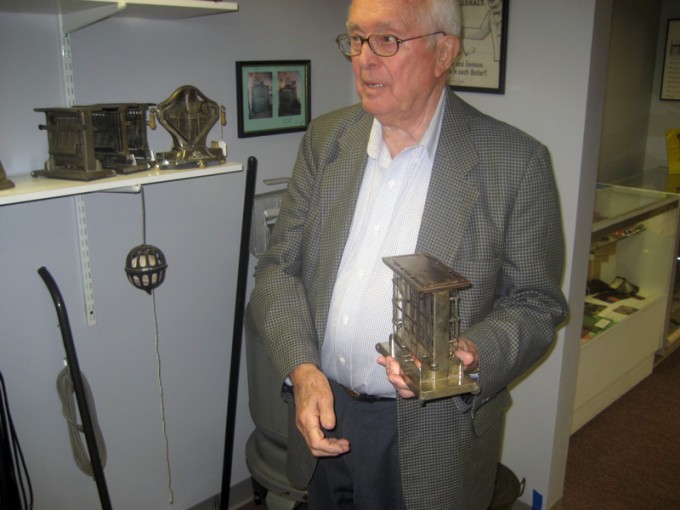
Old timey toaster
This wasn’t, as you might think, one of those quirky odd museums like you laugh about. After all,if you know anything about New Britain is that it was THE industrial city for a good number of years. Consequently, it had an interesting story to tell (As well as a number of smaller, boring ones. I mean, the history of the belt sander? Yikes). One of my favorite exhibits was the row of toasters. I liked it because it was like seeing the famous “evolution of man” drawing only in toaster form. Let’s just say the early toasters (one pictured, above) were somewhat primitive. Red hot coils with a wire mesh in front of it. I would’ve just gone the extra mile and had the whole thing start with a small fire. I mean, that’s how prehistoric man made their toast so it’s only fitting.
Thank you Ed – I think this is the only page where his words remain in perpetuity – and thank you Warren, Horace, and the New Britain Industrial Museum!
![]()
New Britain Industrial Museum
CTMQ’s Museum Visits

 Lillian F.B. says
Lillian F.B. says
October 2, 2007 at 9:22 amI have a Whirl Wave
Electric clothes Washer
Landers, Frary, & Clack
New Britain, Conn. U.S.A.
Will visit museum soon.
Wish to sell the Whirl Wave to the Industrial Museum.
 Dave S. says
Dave S. says
July 3, 2008 at 6:52 amI was looking for more information on the C.P. Merwin brick company of New Britain and Berlin.
 Miles Stray says
Miles Stray says
December 15, 2008 at 10:28 amI have a minature pallet jack including a minature pallet that is maked “THE YALE AND TOWNE MFG. CO PHILADELPHIA, PA. It is most likely a salesman sample as it fits into a carrying case with a handle. I’m not sure of the origin or age but my father worked for, then was the owner and president of, Charles A. Templeton Industrial Supply in Waterbury, CT. Age is uncertain but it’s been in my posession for over 50 years. In cleaning out the house and disposing of various items, I can’t bring myself to throw this out as it may be of value to someone in a museum of industry. If your organization has any interest or can refer me to a source that might be interested in such an item please let me know. I can take didital pictures to send to any interested party.
 Courtney Molter says
Courtney Molter says
January 17, 2009 at 5:41 amGreetings!
I would like to take my Engineer boyfriend to the Museum on Friday, January 23rd. What are your hours of operation, if any, on that date? Is there a co-pay and if so, how much? Also, can we have a tour guide?
Thank you in advance for your response!
Sincerely,
Courtney Molter
 Brian Anderson says
Brian Anderson says
October 10, 2009 at 7:30 pmI have an old line shaft milling machine that I don’t use anymore, would you be interested in it for the museum?
 Lorraine Stub says
Lorraine Stub says
January 20, 2010 at 5:32 pmI enjoyed your account of visiting The Industrial Museum. Sadly, Warren Kingsbury died January 14, 2010. Warren was a former mayor of Berlin, CT with a passionate love of history and community. He was a dear, sweet gentleman who will be greatly missed.
 FloG says
FloG says
October 15, 2010 at 12:12 amI have meat grinder with name UNIVERSAL LE&C NEW BRITIAN, CONN,USA,very heavy and rusty, probably over 70 yrs old. Cleaning out my basement and wondered if it has any value.
I enjoyed reading this artical.
 Steve says
Steve says
October 15, 2010 at 9:58 amFloG,
I have a very difficult time believing that you enjoyed the article, as you apparently missed the rather glaring fact that this blog has absolutely nothing in the world to do with the New Britain Industrial Museum and therefore cannot advise you on some old rusty piece of junk from your basement.
 Lois Blomstrann says
Lois Blomstrann says
November 19, 2010 at 11:06 pmI don’t know whether or not Warren’s family have seen your story of your visit to the Industrial Museum but I am going to make sure that they do. Thank you so much. I think a copy of your article should be put on the wall of the museum. I write the Quarterly Newsletter for the Museum and would like to get in touch with you for permission to reproduce.
 Rocio Lindboe says
Rocio Lindboe says
January 11, 2011 at 10:15 amHi, Neat post. There’s a problem with your site in internet explorer, would check this… IE still is the market leader and a big portion of people will miss your excellent writing due to this problem.
 Jan says
Jan says
November 13, 2011 at 6:54 pmI have a work bench with cast legs and an old 2″thick pc of wood 6ft length legs stamped “The New Great Britian Machine Co, Conn USA
Patent Nov. 5, 1905”
any information on this?
any interest?
 EdHill says
EdHill says
December 21, 2012 at 12:00 pmJessica still excoriates me for that outfit. Green cable knit sweater and painters jeans. I was just so provincial! Now im a fancy city boy.
 John Baldino says
John Baldino says
September 27, 2014 at 11:13 amI am trying to locate a magazine from Fafnir’s New Britain plant printed during WWII, the cover has a picture of two young woman (Natalie and Mary Baldino) I am interested in mostly the cover. My father was the oldest of 11 and serving in France when he received a copy from his sisters, his bunk mates went wild !!!! Is there a site or a collection of these local (in house) magazines?
 Jeff Sanborn says
Jeff Sanborn says
November 18, 2014 at 9:35 pmI’m trying to locate information regarding a vise-like tool made by the New Britain Machine Co. If I could have a different email address to which I could attach a picture, that would be great. I appreciate it if someone could tell me what it is. Thanks
 Peter McEldowney says
Peter McEldowney says
March 18, 2024 at 11:29 amI went to this little museum a few days ago. One of my favourites. The guided tour by Mr Judd was excellent. I thoroughly enjoyed it.
It’s only one large room, crammed with items.